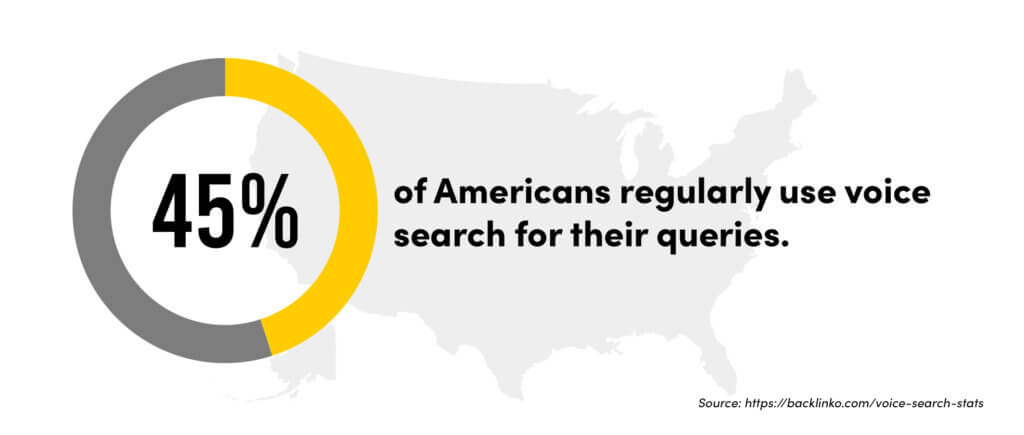Key points*
- Use conversational content and FAQs to match how people speak in voice searches.
- Optimize for local SEO, speed, and mobile to improve voice search performance.
- Aim for featured snippets with clear, concise answers to common questions.
*This is an AI-assisted summary, but was reviewed and edited by a writer for accuracy and clarity.
Voice search allows users to navigate websites and perform searches using their voice rather than typing. I often use this feature while driving or when I am walking in crowded places like an airport. The technology that powers voice search is called Automatic Speech Recognition (ASR), which transforms spoken language into text, allowing search engines to understand and respond to voice queries. Voice Search Optimization, or VSO, is the practice of fine-tuning your website’s content and design to show up more prominently in results from voice-based searches.
So what are some basic things to think about when optimizing your B2B website for voice search? Below are 5 key things you need to do to optimize for voice-to-text searches:
1. Use conversational language and include a FAQ section
Using conversational language on your website is better for voice search because it aligns with how people naturally speak when using voice assistants. Voice searches tend to be full questions or phrases (e.g., “What is the best CRM for B2B businesses?” instead of “best CRM B2B business”).
Make sure to also include Q&A-style content, like a FAQs section, to reflect how people talk. Voice searches are often questions instead of statements or a few key words. When you format your content in a question-and-answer style, it helps Google and other search engines easily understand and index your content. This boosts your chances of being featured in voice responses.

2. Include local SEO (if relevant)
Many voice searches include “near me,” even in B2B (e.g., “industrial supplier near me”). If your website is optimized for local SEO, you’re more likely to show up in those results. Make sure your business name, address, and phone number (NAP) are accurate and match what’s on your website. This is essential. It’s one of the top sources Google uses for local voice searches.
Another thing that helps boost local VSO for your B2B website is creating location-specific website pages. If you serve multiple areas, make a unique page for each one. For example:
yoursite.com/it-services-chicago
yoursite.com/it-services-phoenix
Each page should include localized content that speaks directly to that area’s audience.
3. Speed matters
Voice search results tend to favor fast-loading pages. Optimize images, reduce code bloat, and make sure your site is mobile-friendly. Clean up unused plugins and themes. Extra plugins or outdated themes can drag the page speed of your website down.
Use lazy loading for images and videos. This means media only loads when it enters the user’s view (rather than all at once). Lastly, run speed tests and monitor performance.
Some helpful tools to review speed/performance:
- Google PageSpeed Insights
- GTmetrix
- Lighthouse (in Chrome DevTools)
4. Mobile optimization is a must
Most voice searches happen on mobile devices, so your website should be fully responsive and easy to navigate on phones and tablets. Use responsive, mobile-optimized design. Speed isn’t just about load time—it’s also about perceived speed. A mobile-friendly design that loads cleanly and quickly makes the experience feel faster.
Plus Google uses mobile-first indexing. This means Google primarily looks at your website’s mobile version when ranking it in search results. If your mobile site falls short, strong desktop performance won’t make up for it.
5. Use featured snippets as a target
Google often pulls voice search answers from featured snippets. A Google featured snippet is a highlighted text box that appears at the very top of the search results page (often called “position zero”). It provides a quick, direct answer to a user’s query—so they get the info they need without having to click through to a B2B website. These snippets are designed to deliver fast, useful information right within the search page. Structure your content to win these by clearly answering questions near the top of your page in 40–60 words.
Final thoughts
The era of voice and AI isn’t on the horizon — it’s already arrived. B2B brands that stand out will be the ones that speak like real people, communicate with clarity, and design B2B websites not just for users, but for the AI systems guiding their choices. If your site doesn’t have a voice yet, it’s time to give it one.
Interested in discussing your B2B marketing strategy and website? Contact us today to see how we can help you reach your goals.



